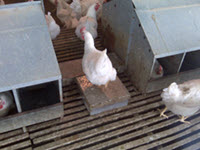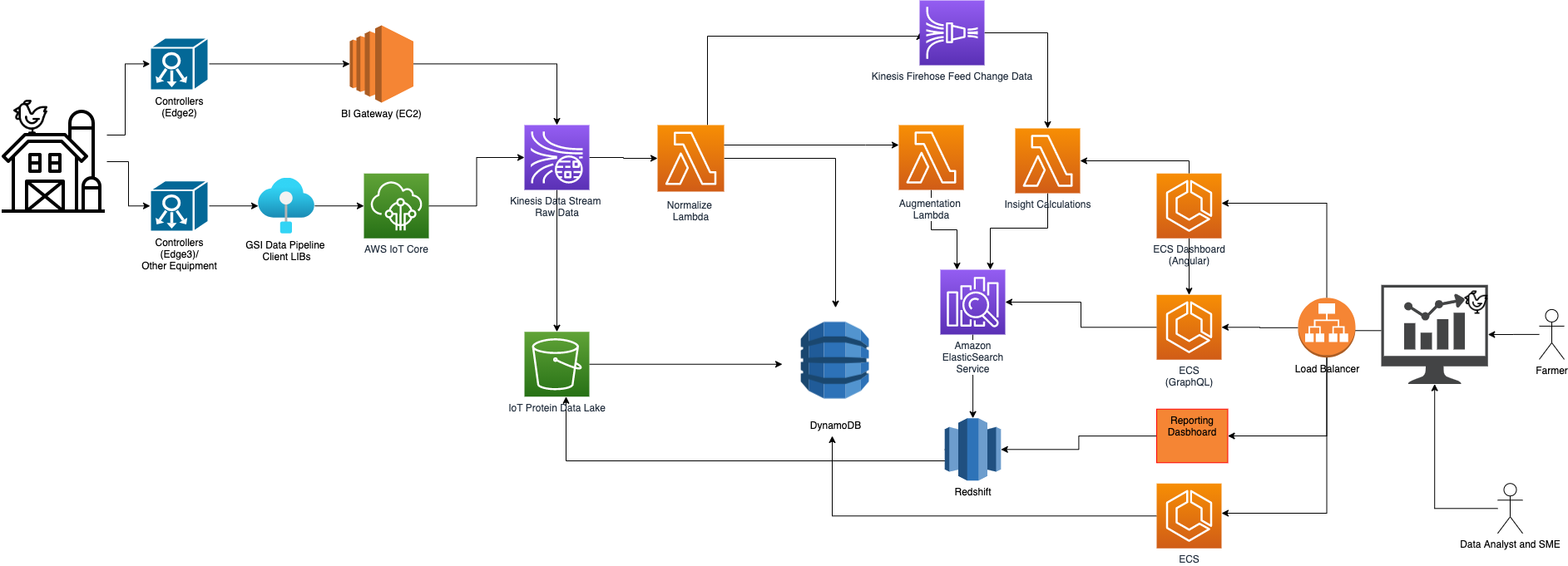AWS for Industries
Livestock Health and Quality of Life Monitoring on AWS with Agriculture Leader AGCO
September 8, 2021: Amazon Elasticsearch Service has been renamed to Amazon OpenSearch Service. See details.
Introduction
AGCO is an international Agriculture company focused on professional farm machinery that customers use through every phase of the farming process. AGCO’s Grain & Protein product lines include: a full-line of feed storage and delivery systems, feeders, scales, ventilation, lighting, and environmental controls for livestock production, in addition to diesel engines, tractors, combines, sprayers, seeding, and tilling equipment for crop farming. Global organizations recognize AGCO as an innovator for industry-leading work in manufacturing and machine engineering. In 2020, AGCO won the Internet of Things (IoT) World Award in the “Manufacturing IoT Deployment” category at the Internet of Things World conference. As technology components become affordable, and internet connectivity becomes ubiquitous, farms are operating, building, and deploying Internet of Things (IoT) devices more routinely. Their focus is becoming less on “if”, and more on “how” to implement IoT solutions to solve problems. AGCO deploys building blocks of serverless technologies, IoT and API communications, machine learning, and advanced analytics running on Amazon Web Services (AWS) to allow for rapid deployment and innovation of future solutions.
Overview
The agricultural industry faces decades of work to supply a growing population with the healthiest and most ethical foods available to consumers. The last decade has seen perhaps the greatest transition in farming since the introduction of the combustion engine. Farmers now use sensors and networks to assess the near-real-time status of their farm, sending information to a centralized location for visualization of data to make better decisions. Although machine learning and advanced analytics is common in advanced vehicle production systems and biochemical laboratories, today new livestock production leverages these solutions under the term “precision farming”. The use of historical data, real-time insights, and predictive analytics from machine learning models, now provides farmers capabilities to optimize the efficiency of resources.
Digital transformation enables a leap forward in the precision farming world. Farms across the industry are starting to digitize their production from top to bottom. Transformations include sensors on devices in-field, on-animal, flown over, and integrated into machinery. The farming industry has been functioning near peak efficiency for years, but it must figure out how to meet the expected increase in demand. According to agriculture experts from Statista, global livestock populations are estimated at 700M pigs, 1B cattle, and 25B chickens. Even at those levels, animal protein consumption is predicted to grow in another 10% over the next ten years. This growth accounts for chickens amounting to over half of that growth. AWS is working with AGCO on ways to meet these increased demands on farms and allow them to operate efficiently with technological precision.
Solution
The Grains and Protein division of AGCO is working to produce remote equipment performance monitoring, production optimization insights, and feedback on input resources management for poultry and swine that are feeding from the supply bins. When animals arrive to the growing facility, they need a constant and reliable supply of feed, water, and favorable environmental conditions. Understanding the real-time feed levels, rates of consumption, and the estimated remaining time of the current stock of feed typically requires farmers physically visit a site and manually take measurements. Historically, animals’ weight and well-being is maintained through physical full body inspections and weight measurements by farmers and production supervisors. This is labor-intensive work and measuring across tens of thousands of animals is difficult to do manually. Ultimately, farmers need a deeper level of data, collected through automated systems, and reported through remote connections to understand animal health, well-being, and contamination. Collecting near real-time feed and animal weight data will aid in maintaining a healthy supply of food, and accurately predict when the bins will run out of feed.
The AGCO livestock Health and Quality of Life Monitoring system informs farmers about levels of feed and rate of consumption, and sends alerts upon nearing dangerously low levels. This system provides information for current and projected feed levels, and growth rates across the farm. Uninterrupted access to feed leads to happier and healthier lives for animals and decreases events that cause variance in predictable growth for the farmer. The Grain and Protein division of AGCO’s solution will provide insights from the livestock lifecycle data that report and project actions for how farmers should feed, water, and increase their livestock’s quality of life. Farmers are able to quickly understand current states, but also get machine-learning driven recommendations and insights about the future.
Examples
AGCO is developing a smarter platform to empower farmers and integrators with the insights they need. There are three major components to the platform:
- Load cell sensors on poultry feed bins and platform
 scales that transmit to a central controller. Tagging, tracking, and tracing tens of thousands of birds per site every two months is financially valuable or logistically feasible through automation. AGCO sensors attached to feed bins constantly measure the weight of feed remaining. Platform scales near feed stations in the barn gather data on the weight of the birds. These sensors transmit to a controller gateway, which then sends data to the AWS Cloud.
scales that transmit to a central controller. Tagging, tracking, and tracing tens of thousands of birds per site every two months is financially valuable or logistically feasible through automation. AGCO sensors attached to feed bins constantly measure the weight of feed remaining. Platform scales near feed stations in the barn gather data on the weight of the birds. These sensors transmit to a controller gateway, which then sends data to the AWS Cloud.
Detailed information about sensors, information on the sensor’s model numbers  and hardware specifications, are kept out of the regularly communicated data messages to minimize bandwidth. When a sensor is initially provisioned, or when a system comes ‘online’, the sensor details are transmitted and stored in an Amazon DynamoDB table. This database creates a digital twin of each piece of equipment. Buildings, rooms, and other farm groupings can be configured to represent their physical counterparts.
and hardware specifications, are kept out of the regularly communicated data messages to minimize bandwidth. When a sensor is initially provisioned, or when a system comes ‘online’, the sensor details are transmitted and stored in an Amazon DynamoDB table. This database creates a digital twin of each piece of equipment. Buildings, rooms, and other farm groupings can be configured to represent their physical counterparts.
- An ingestion system for processing the data, running models, and estimating target metrics. AGCO is building their Business Intelligence portal. It is run on Amazon Elastic Container Service (Amazon ECS), Amazon OpenSearch Service (successor to Amazon Elasticsearch Service), and code managed through the AWS CodePipeline. The system receives data from the farm-based controller gateway, decrypts and prepares the data for processing, and then transmits it to a raw Amazon Kinesis Data Stream. The Raw Kinesis Data Stream feeds into Amazon Simple Storage Service (Amazon S3) bucket and a Lambda function event where the data is validated and normalized. The normalized events have different downstream components including Kinesis Firehoses, an Augmentation AWS Lambda Function, and Amazon Simple Notification Service (Amazon SNS) topics to trigger AWS Lambda functions to calculate the animal feeds and water consumption. First, a Normalized Amazon Kinesis Data Firehose receives data messages and runs a Normalized Data Enrichment Lambda function to combine the Normalized Data with the farm and device data from the DynamoDB tables. Data is loaded into an Amazon ES database for the primary data visualization tool to access. The next downstream component of the Normalized Kinesis Data Stream is a Normalized Data Archive in Amazon S3 for potential R&D or BI teams to review. The final downstream component is a Downstream Kinesis Firehose that takes data from the Normalized Kinesis Data Stream to make data available for potential integration to other AGCO products the farmer uses. These three different components move data in a hyper-scalable and decoupled model.
- A Self-service Dashboard with Insights, Alarms, and Predictions. While this testing data from the Normalized Kinesis Data Stream is available via the Downstream Kinesis Firehose to the R&D and BI teams, the goal of the system is to present the live data and analytical analysis to farmers through a data visualization tool. AGCO’s Smart Protein dashboard presents data and provides configurations for monitoring, trend analysis, and notifications. Data from the Normalized Kinesis Data Firehose is sent to an Amazon ES database. The Smart Protein application is containerized and uses Amazon ECS to serve the application to end users. This data visualization system uses the sensor data from the Amazon ES database and the device metadata from DynamoDB. End users customize data visualizations to see the feed data they are responsible for, view estimates of when the animals will reach their target weights, and see estimates and notifications that the feed stations are low. If customers configure calculations to estimate consumption levels or calculations of target growth rates, the Downstream Kinesis Firehose is available to calculate these data points on-demand, update them into the Amazon ES database, and present them in the Smart Protein dashboard.
AGCO needs the ability to build, test, and destroy/delete multiple types of compute, database, data pipelines, and networks to iterate and innovate. Standing up an Amazon ES instance, comparing the latency to an accessed object store, then tearing that down allows the team to validate designs for the work day. Innovation at the global deployment level with billions of messages requires a partner such as AWS. AGCO sees the Smart Protein solution as being able to grow quickly with new data visualizations and with Machine Learning integrated insights. Devices writing from farms to a database in a traditional datacenter caused critical data access issues, but the AWS solution led to a 600% performance improvement. AGCO’s testing is approaching 1.9M device messages a day, but this system is load tested to handle 100,000 messages a minute. AGCO is processing these 1.9M data records a day with over 1 billion records in DynamoDB and growing. Even at that scale, the AWS hosted system provided a cost savings of 78% versus a similar system AGCO tested on-premises. Together, these systems allow AGCO to deliver tools to farmers reliably and cost effectively.
Conclusion
Innovation at this scale and speed is leading to the next generation of solutions. Machine learning driven analytics that provides farmers with strategies to maximize yields, and farmers forecasting the feed needs, identifying when animals are ready to transport, and determine times when the farm houses are empty. Instead of real-time data, farmers can forecast the schedule of their work and coordinate in advance with teams effectively. Enabling farmers to be precise in their work is key to feeding the growing global demand over the next generation. AGCO is delivering these precision farming results, at massive scale, using AWS. For more information on AGCO and upcoming innovation, check out AGCO’s website at https://www.agcocorp.com/.
